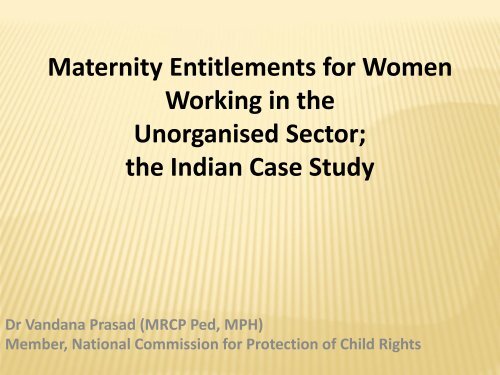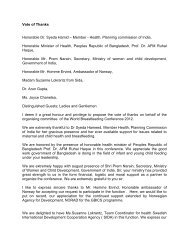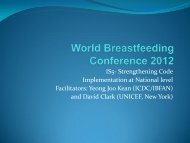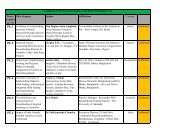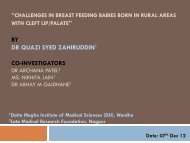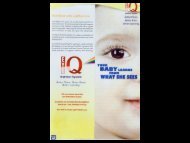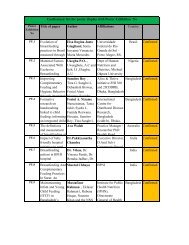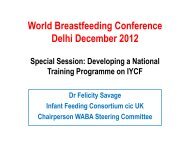4_ Dr Vandana Prasad ppt.pdf - World Breastfeeding Conference
4_ Dr Vandana Prasad ppt.pdf - World Breastfeeding Conference
4_ Dr Vandana Prasad ppt.pdf - World Breastfeeding Conference
You also want an ePaper? Increase the reach of your titles
YUMPU automatically turns print PDFs into web optimized ePapers that Google loves.
Maternity Entitlements for Women<br />
Working in the<br />
Unorganised Sector;<br />
the Indian Case Study<br />
<strong>Dr</strong> <strong>Vandana</strong> <strong>Prasad</strong> (MRCP Ped, MPH)<br />
Member, National Commission for Protection of Child Rights
SECTIONS<br />
• Conceptual issues:<br />
• For whom? (Woman? Child? Both? Society?<br />
• For what objectives? (wage compensation?<br />
Health objectives? Nutritional objectives?<br />
• Why?<br />
• Operational issues: how
Conceptual Issues<br />
• Women’s labour right; protection of<br />
employment and social support during<br />
pregnancy, delivery and lactation<br />
• Impact on maternal morbidity and mortality<br />
• Impact on birth weight<br />
• Impact on exclusive breastfeeding and thus on<br />
neonatal and infant mortality, growth and<br />
development
FINAL ANALYSIS<br />
Wage compensation for support to<br />
exclusive breastfeeding and early<br />
childcare is the only concept that can<br />
fully justify maternity entitlements.<br />
(nutrition and health for child is primary<br />
conceptual objective, partially health for<br />
mother)
Indian Benchmark;<br />
Recommendations Sixth Pay Commission<br />
• The existing ceiling of 135 days Maternity Leave provided in Rule 43(1) of<br />
Central Civil Services (Leave) Rules, 1972 shall be enhanced to 180 days.<br />
• Leave of the kind due and admissible (including commuted leave for a<br />
period not exceeding 60 days and leave not due) that can be granted in<br />
continuation with Maternity Leave provided in Rule 43(4)(b) shall be<br />
increased to 2 years.<br />
• Women employees having minor children may be granted Child Care<br />
Leave by an authority competent to grant leave, for a maximum period of<br />
two years (i.e. 730 days) during their entire service for taking care of upto<br />
two children whether for rearing or to look after any of their needs like<br />
examination, sickness etc.. During the period of such leave, the women<br />
employees shall be paid leave salary equal to the pay drawn immediately<br />
before proceeding on leave. It may be availed of in more than one spell.<br />
Child Care Leave shall not be debited against the leave account.
Current Inequities<br />
• Applicable to a very small number of women<br />
(about 0.15% in the civil services)<br />
• Back of envelope costs for child care leave<br />
about Rs 12 lakhs per woman central<br />
government employee<br />
• As against zero financial entitlements for over<br />
90% women working in the informal sector
CURRENT SCHEMES<br />
• Indira Gandhi Matritva Sahyog Yojana (IG<br />
support to maternity scheme):<br />
• Promoting appropriate practices, care and service utilisation<br />
during pregnancy, safe delivery and lactation<br />
• Encouraging the women to follow (optimal) Infant and Young<br />
Child Feeding (IYCF) practices including early and exclusive breast<br />
feeding for six months<br />
• Contributing to better enabling environment by providing cash<br />
incentives for improved health and nutrition to pregnant and<br />
nursing mothers.<br />
No wage compensation / labour / equity considerations
Inclusion and Exclusion<br />
• BPL only<br />
• Age under 19 yrs<br />
• Unwritten targets for family planning<br />
still persist as well as two child norm<br />
in policy<br />
• Tends to exclude a woman delivering<br />
at home
PRELIMINARY FINDINGS FROM A STUDY ON THE IGMSY<br />
FROM AN EQUITY AND ACCOUNTABILITY PERSPECTIVE<br />
IN 4 SELECTED DISTRICTS OF FOUR STATES (NAMMHR)<br />
• 48% women will be ineligible if exclusion criteria of 2 child<br />
norm and age over 19yrs as per IGMSY are adopted (Lingam<br />
and Yelamanchili, 2011)<br />
• Women who are forced to go back to work early are not in a<br />
position to provide enough care for their infants by<br />
following exclusive breastfeeding or even sufficient care<br />
since there is a lack of facilities like crèches or day cares<br />
where the children can be kept safely or attended to at regular<br />
intervals. Thus this work is often done by older children who<br />
forego school and attend to other domestic chores or take care<br />
of the infants.
• After the birth of the infant despite the loss of incomes<br />
women choose to stay back foregoing precious money that is<br />
necessary for the survival of the family as a whole. This cost<br />
may be covered by additional burdens that other family<br />
members both children and adults might have to undertake or<br />
else through loans taken at considerable interest rates. This<br />
means a further depletion of assets and future incomes<br />
• criteria for eligibility are in fact leaving out some of the<br />
most vulnerable women and penalising them for making<br />
choices that are shaped by the imperatives of survival. The<br />
study findings clearly show that maternity is a time of great<br />
economic vulnerability and at the same time it is also a period<br />
of increased expenses; which has often resulted in further<br />
impoverishment of poor women and increased indebtedness.<br />
.
Recommendations<br />
• Objectives of maternal entitlements should be clear and<br />
consistent with the concept of wage compensation<br />
• Universality is desirable and achievable and should not<br />
be compromised by adding conditionalities not related to<br />
the concept of maternity entitlements (institutional<br />
delivery etc)<br />
• Wage compensation should be adequate and equitable<br />
(6 th Pay Commission)
Recommendations Contd.<br />
• Good implementation should be commensurate with<br />
objectives<br />
– capacity building for purpose of the scheme;<br />
linking it to EBF and wage compensation<br />
– prevention of delays<br />
• Health care services should be made free and<br />
available to all so that money is spent on<br />
nutrition and not on seeking health care.
Thank You!


